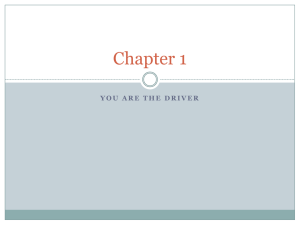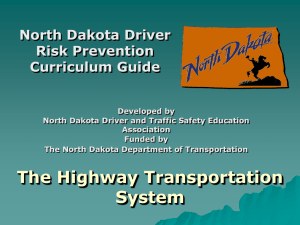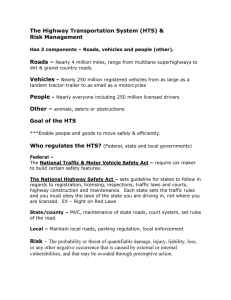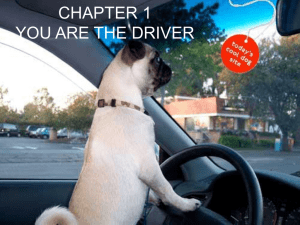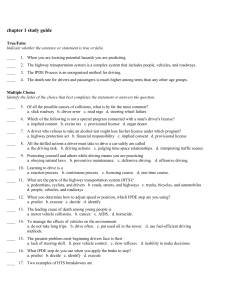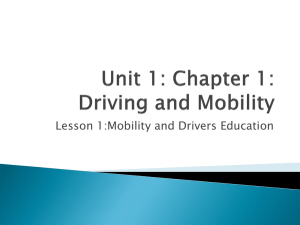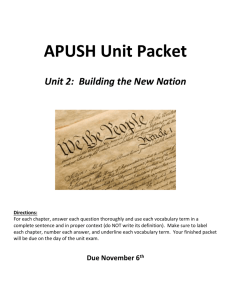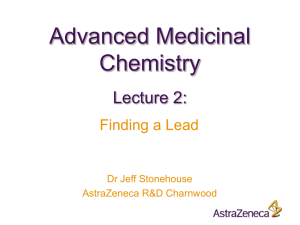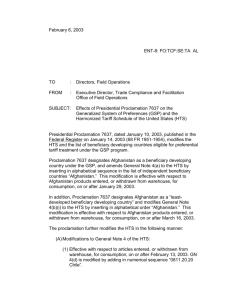Chapter 1 Worksheet - Freedom High School
advertisement
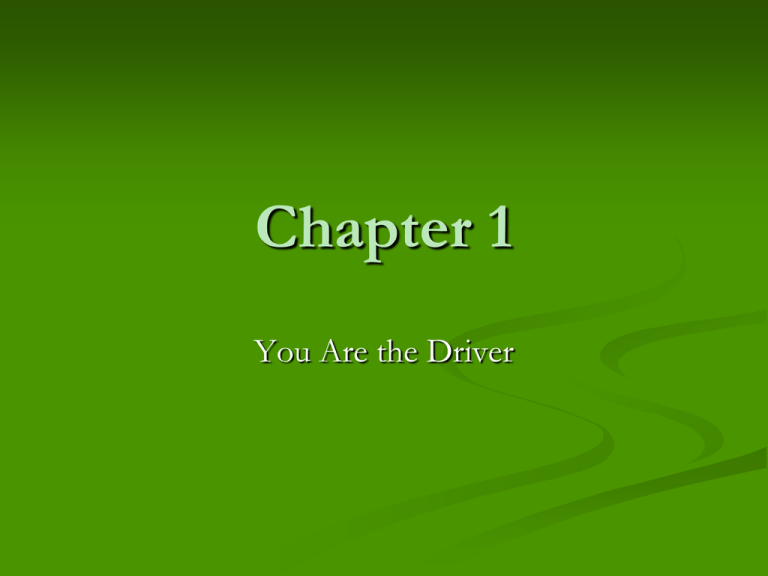
Chapter 1 You Are the Driver The Highway Transportation System (HTS) People, vehicles, and roadways Purpose is to move people and cargo from one place to another in a safe, efficient, and economical manner Drivers, passengers, motorcyclists, bicyclists, and pedestrians Simple rural lanes – complex multi-lane urban roads and expressways Roadway Users People who are: Walking Driving Riding Vehicles Mopeds and motorcycles are small and have very little protection for the riders Tractor trailers that weigh tons Cars, vans, small trucks, buses, campers, farm vehicles and construction equipment Roadways Vary from dirt lanes to complex multilane expressways Common conditions such as rain, nighttime, or rough pavement can become major problems Regulating the HTS Drivers who operate their vehicles in a responsible, low risk manner are the most important part in the HTS Laws make up the vehicle code Enforcement agencies assure that laws are obeyed DMV set rules for driver and vehicle standards Courts decide if drivers are guilty or innocent Highway traffic engineers plan, build, and maintain the complex system of roadways Driving Task Includes social, physical, and mental skills Using knowledge and visual skills Obeying traffic laws Judging time and space Anticipating how our car will respond under normal and emergency conditions Social Skills Drivers must interact successfully with people which includes communicating with other roadway users Courteous drivers obey traffic laws and make an extra effort to work with other drivers Without courtesy and cooperation, low-risk driving is impossible Physical Skills Beginning drivers need to learn the physical skills of driving so they will become natural habits Steering Braking Accelerating Stopping Starting Mental Skills Safe low-risk driving is primarily a mental or thinking task that involves decision making. Physical skills are minor when compared to the necessary decision-making skills The IPDE Process A process of seeing, thinking, and responding Identify important information in the driving scene Predict when and where possible points of conflict will develop Decide when, where, and how to communicate, adjust speed, and/or change position to avoid conflicts Execute the right action(s) to prevent conflict Your Driving Responsibilities Your attitude toward life and driving affects your willingness to learn and effectively use safedriving habits The best defense against a driver who has road rage is to distance yourself Drivers who drive in a responsible low-risk way will gain respect from others Breakdowns in the HTS A breakdown in the HTS occurs when any part of the system does not work well. Traffic tie-ups Collisions Construction Disabled vehicles Collision or Accident? Collision usually have more than one cause Driver error is the most common cause of collisions which includes the following: Breaking various laws Not slowing in adverse conditions Operating a defective vehicle Following too closely Driving while intoxicated or very tired Not wearing safety belts Causes of Death Out of all methods of transportation the most deaths occur while driving motor vehicles Lack of experience is a major factor Some other factors include increased exposure to night driving, increased risk taking, susceptibility to peer pressure, and mixing drinking and driving Traffic collisions cost our nation billions of dollars each year in property damage, time away from work and school, medical fees, and insurance premiums Financial Responsibility As a driver, you are responsible for your share of driving-related costs. Fuel Maintaining and insuring your car You also are financially responsible by law for any damage or injuries that you may cause Graduated Licensing Program Requires young drivers to progress through a series of licensing stages. Zero tolerance for blood alcohol concentration (BAC). Permit stage Intermediate license stage Full-privilege license stage Organ Donor Program Filling out an organ donation declaration that will appear on your license. Inform your family about your decision. Implied Consent Law You agree to take an alcohol test on request. If you refuse you will lose your license. Recap Highway Transportation System Roadway users Vehicles Roadways Regulating the HTS Driving Task IPDE Process Driving Responsibilities Breakdowns in the HTS Collisions Cause of death Financial Responsibility Chapter 1 Worksheet 1. What are three parts of the Highway Transportation System (HTS)? 2. What is the primary purpose of the HTS? 3. Define “driving task” 4. Why is driving a social task? 5. Define “collision” 6. What are the four steps of the IPDE process? Chapter 1 Worksheet 7. A collision occurs between a speeding car and a truck driven by a driver who was upset. This is an example that most collisions have _____________ causes. 8. Define “defensive driving” 9. Why is conserving fuel important? Essay How do you think television programs, movies and commercials influence driving behavior?

